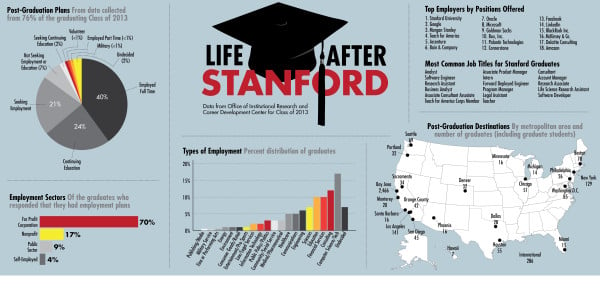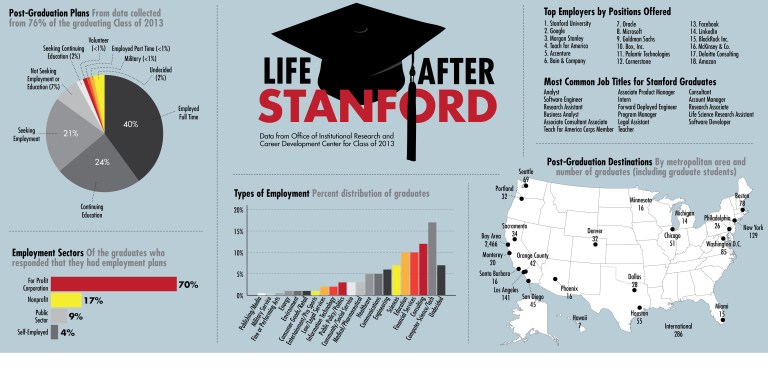As the Class of 2014 prepares to leave Stanford, many wonder where they will be headed next. Based on the data from the class of 2013, the Career Development Center (CDC) projects that 40 percent of the Class of 2014 will head into full-time employment, 24 percent will continue on into graduate or professional school and 21 percent will still be seeking employment.

Another seven percent of students fall into the “not seeking employment or education” category, which Farouk Dey, the executive director of the CDC, explained is mainly students who take time off to travel. He said that there are also some students who “just take time off to figure out what their next move is.”
The remaining eight percent is attributed to students with part-time employment, volunteer positions, students entering the military, those who are seeking continuing education or are still undecided.
Farouk Dey explained that while the percentage of unemployed students will likely decrease by June (the data is taken in March), there are reasons why some students face more difficulty landing jobs than others.
“The number one reason is not starting the process early enough,” he said. “That’s the number one mistake that students make, and that they delay the process until spring quarter.”
One common misconception among students is that their choice in major will affect their competitiveness in the job market. Dey stressed, however, that majors very rarely matter.
“Employers don’t discriminate by major, they discriminate by skill level and enthusiasm and potential,” he said. “I have not seen a problem with specific majors. It’s easy to go there with stereotypes, but that’s not what I’ve found.”
Dey explained that students who enter senior year with internship experience, however, often have a leg up in finding employment.
“Students with internships tend to engage in the process early and tend to have connected with careers and within a network much earlier,” he said. “They tend to get those offers in hand really early.”
Based on the 2013 data, the CDC found that the top fields that Stanford graduates go into are technology (17 percent), consulting (12 percent), financial services (10 percent) and education (10 percent). Further, the top five employers for Stanford students are Stanford University, Google, Morgan Stanley, Teach for America and Accenture.
Dey stressed that the most popular fields will likely change in the coming years, however, as the CDC changes its structure.
“Students tend to go to into these sectors [consulting, computer science, finance] because of their interests…but also sometimes because those are the opportunities that come their way,” he said. “We recognize at the career center that there are underrepresented fields in the career centers in terms of job postings and representation.”
The CDC will be hiring industry experts in several new areas in an effort to connect more students, including a career consultant for social impact careers.
“We are currently redesigning our program in order to meet these demands,” he said. “Within a couple of years you should see different numbers.”
Contact Lucy Svoboda at lsvoboda ‘at’ stanford.edu.
